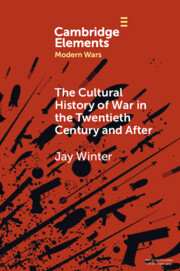Element contents
The Cultural History of War in the Twentieth Century and After
Published online by Cambridge University Press: 11 August 2022
Summary
Keywords
- Type
- Element
- Information
- Series: Elements in Modern WarsOnline ISBN: 9781009110303Publisher: Cambridge University PressPrint publication: 25 August 2022
Bibliography
- 3
- Cited by

